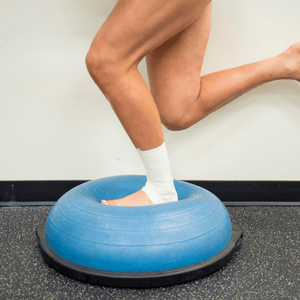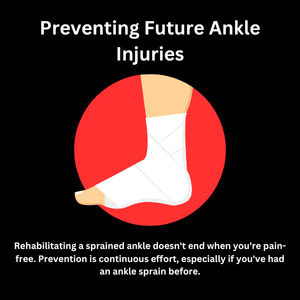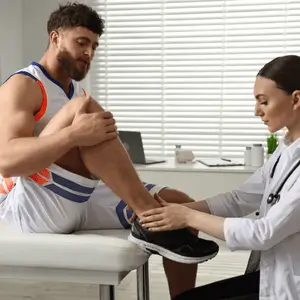Ankle sprains rank among the most common musculoskeletal injuries. They affect athletes, active people, and seniors in daily life. In the United States, about 2 million ankle sprains occur each year. They happen when your foot twists beyond its normal range. This overstretches or tears the ligaments connecting your ankle bones.
Most sprains are acute lateral ankle sprains. These result from your foot rolling inward. This damages ligaments on your ankle’s outer side. A sprained ankle depends on injury severity. It can range from mild stretching (Grade 1) to partial tear (Grade 2) or complete rupture (Grade 3). More severe sprains cause major pain, swelling, and instability.
Proper rehab matters greatly. Without good care, even a mild injury can cause chronic problems. Studies show up to 70% of people with acute ankle sprains may develop lasting issues. These include ongoing pain, muscle weakness, or chronic ankle instability. This happens especially when the ankle heals incompletely or rehab stays incomplete.
Once you sprain an ankle, you face higher risk for repeated ankle sprains. This occurs if strength and balance aren’t fully restored. The good news is therapy for sprained ankle dramatically improves outcomes. Research shows patients are less likely to suffer long-term instability or reinjury with guided physical therapy rather than just rest alone.
Physical therapists help reduce pain and swelling in the acute stage. They also prescribe targeted ankle exercises to restore your ankle’s range of motion, strength, and balance. These are key factors in full recovery.
Immediate Care for Acute Ankle Sprain
The first 1-2 weeks after an ankle sprain are critical for acute recovery. This phase focuses on protecting your injured ankle, reducing pain and swelling, and gently beginning motion as tolerated. Initial treatment often follows the R.I.C.E. protocol: Rest, Ice, Compression, and Elevation.
Rest and Protection

Avoid any activity that causes pain in your injured ankle sprain. Don’t push through acute pain. Using the affected foot too soon can worsen the ankle sprain or cause further damage. For a mild ankle sprain, this may mean wearing a soft ankle brace or wrap and being careful with weight-bearing on the affected foot. For more severe ankle sprain injuries, use crutches or other walking aids if putting weight on your affected foot causes too much pain.
Keep your knee straight when moving to avoid strain on the injured ankle and your other leg. Rely on your good leg to reduce pressure on the affected foot. According to orthop sports phys ther experts, proper care and early rest are key for healing. In athletic training, ankle rolls are a common injury, so recognizing limits early and keeping the knee straight can help recovery and avoid re-injury of the affected foot.
Ice and Swelling Control
Apply an ice pack wrapped in cloth to the swollen area for 15-20 minutes at a time, several times daily. Ice helps reduce swelling and can numb pain in your ankle joint. This step is essential in early ankle sprain care. Never place ice directly on skin. Use an elastic bandage for compression. Snug but not overly tight compression can reduce swelling and support your ankle joint. A physical therapist may also recommend gentle movement and calf stretch routines to maintain flexibility in the ankle joint.
Doing a calf stretch with the back heel down and keeping balance on the other foot can aid healing. A physical therapist can guide you on safe movements, especially if the ankle sprain affects walking. Studies in br j sports med support icing and compression. A physical therapist may also monitor the achilles tendon for strain. Relying on the other foot during movement helps protect the healing side, while regular sessions with a physical therapist ensure proper recovery.
Elevation and Early Movement
When possible, prop up your injured foot so your ankle sits above heart level. Elevating your ankle helps fluid drain and minimizes swelling, especially during the first 48 hours.
Complete rest beyond the first day or two usually isn’t recommended. Long immobilization can make your ankle stiff and weaken your calf. Instead, early mobilization with protected movement is the modern approach. As soon as you’re able, begin weight-bearing as tolerated on your injured ankle.
Gentle motion exercises are often introduced within the first 48 hours for minor sprains, or as soon as pain allows for more severe injuries. Consult a physician if you have severe symptoms, inability to bear any weight, or if your ankle looks deformed.
Restoring Range of Motion and Flexibility
After immediate inflammation is controlled, physical therapy shifts to restoring your range of motion and flexibility. This typically happens in the second phase of rehabilitation. A physical therapist will guide you through targeted rehabilitation exercises to gently improve joint movement. It may begin just a few days after injury for a minor sprain, or a week or two later for more severe sprains. Working with a physical therapist ensures that rehabilitation exercises are done correctly and at the right pace. Regular sessions with a physical therapist also help prevent complications and promote a smoother recovery.
Basic Motion Exercises
Gentle exercises should be introduced to coax your ankle back to normal range of motion. Ankle range-of-motion exercises are usually the first step. These motion exercises are done without resistance, simply moving your ankle within a comfortable pain-free range.
Ankle circles or alphabet: While sitting or lying, slowly rotate your foot to draw circles in the air. You can trace letters of the alphabet with your big toe. This moves your ankle in all directions and prevents stiffness.
Ankle pumps: Point your foot down like pressing a gas pedal, then flex your foot up toward your shin. Move back and forth in a pumping motion. This helps maintain motion in your ankle and can pump swelling out of the area.
Stretching Exercises
Calf and Achilles stretches are essential at this stage. Your calves tend to tighten after an ankle sprain, partly because you may have been limping. Tight calves can limit your ankle. A classic calf stretch can be done against a wall:
Stand facing a wall and place your hands on the wall for support. Put your injured foot a step behind your other foot. Keep your back leg straight with your heel flat on the floor, and bend your front knee. Lean forward until you feel a stretch in your back leg calf. Keep your back knee straight and heel down to target your upper calf muscle. Hold for 20-30 seconds, then relax.
For a deeper stretch targeting your lower calf, do a similar stretch but with your back knee slightly bent. Regular stretching will help improve your ankle and prevent stiffness in your Achilles tendon and muscles.
By the end of this phase, you should be able to move your ankle up, down, and side-to-side nearly to normal range without sharp pain.
Strengthening Exercises for Ankle Recovery
Once your ankle has basic range of motion back and swelling is controlled, physical therapy progresses to strengthening exercises. Strengthening muscles around your ankle, as well as leg muscles that control your foot, is vital for stabilizing your joint and preventing future sprains.
Early Strength Building
Early strengthening often begins with isometric exercises. These activate muscles without moving your joint. You might sit with your foot against a fixed object and press gently. Push your foot down against the floor, up into your hand, and inward/outward against an immovable object.
Resistance Band Training
As you progress, resistance exercises are introduced. A common tool is a resistance band. The band provides gentle resistance as you move your ankle:
Band dorsiflexion: Tie the band around your foot and anchor the other end. Slowly flex your foot upward against the band’s resistance. This strengthens muscles in your lower leg front.
Band plantarflexion: Hook the band around your foot ball and push your foot downward against resistance. This works your calf muscles.
Band inversion and eversion: These target muscles that support your arch and provide stability.
Calf Raises and Functional Strengthening
Calf raises are extremely effective for strengthening your calf and ankle. Start with double-leg calf raises. Stand with feet shoulder width apart and hold onto a wall or chair for balance. Slowly rise up on your toes, lifting your heels off the ground, then lower back down in a controlled manner.
As you get stronger, try doing this on your affected foot alone. Perform 2-3 sets of 10-15 repetitions as tolerated. If you feel pain, stop or go back to the easier version.
Other strengthening exercises might include toe raises and exercises targeting your hip muscles and glutes. Hip weakness can affect leg alignment and balance, potentially contributing to ankle injuries.
The key is gradual progression. Gradually increase difficulty as your ankle heals and strengthens. Over a few weeks, these ankle exercises will significantly improve strength of muscles and tendons that support your ankle joint.
Balance and Control Exercises for Ankle Stability
One of the most critical components of ankle rehab is balance and control exercises. After an ankle sprain, damage to ligaments can impair your ankle’s position sense, making it easier to roll your ankle again. This is why people with previous sprains often report their ankle feels unstable or prone to repeated ankle sprains.
Single Leg Balance Training

Physical therapists incorporate balance exercises to retrain your body’s ability to stabilize your joint. A simple but effective exercise is single leg balance:
Single-leg stand on flat surface: Stand on your injured leg on flat ground and lift your other foot off the floor. Try to maintain balance for 30 seconds. You might wobble at first as your ankle muscles and nerves relearn to respond.
Eyes closed balance: Once you can do 30+ seconds with eyes open, try the same single leg balance but close your eyes. This removes visual feedback and forces your ankle sensors to work harder.
Progressive Balance Challenges
Uneven surfaces: Practice standing on one leg on a pillow, foam pad, or wobble board. The slight instability forces your ankle and foot to make continuous adjustments. This is excellent training for real-life surfaces like trails, grass, or uneven sidewalks.
Physical therapists often turn these into challenges. You might play catch with a ball while standing on a single leg, or reach in different directions with your other foot while balancing on your injured leg.
Evidence supports balance training as a powerful tool to prevent chronic ankle instability. Clinical studies have found that incorporating balance and control exercises significantly lowers the chance of reinjury after an ankle sprain.
Advanced Rehabilitation and Return to Activity
As strength and balance improve, your rehab enters a more advanced phase. The exact timing varies. A young athlete with a mild sprain might reach this stage in a couple weeks, whereas a senior with severe injury might take months.
Functional Movement Training
In this phase, focus is on functional exercises that prepare you to return to normal daily activities, sports, or whatever physical goals you have. This includes higher-level strengthening, dynamic movements, and eventually sport-specific drills.
Gait training: If you’ve been limping, your therapist will work on restoring normal walking pattern. This ensures you can walk with your heel flat on the ground without pain.
Advanced strengthening: Increase difficulty of exercises like calf raises by adding weights or more reps. Perform functional strengthening like lunges or squats.
Sport-Specific Training
When ready, exercises like side-to-side lateral shuffles, figure-8 running drills, and jump training can be introduced. For athletes, cutting maneuvers and sports-specific movements are practiced gradually.
Dynamic balance exercises come in here, such as hopping onto a balance pad, or doing single-leg squats. One common test is the Star Excursion Balance Test, where you balance on one leg and reach your other leg in multiple directions.
To get you back to longer activities, therapists often incorporate cardio like cycling, swimming, or elliptical trainer to rebuild endurance without overstressing your ankle. As you improve, light jogging can be added, progressing to running.
External Support Considerations
Even as you return to sports, you may use an ankle brace or athletic tape for additional support initially. Studies show external supports can reduce risk of recurrent ankle injury, especially in those with history of sprains. Keep in mind, a brace isn’t a substitute for muscle strength and control.
Preventing Future Ankle Injuries

Rehabilitating a sprained ankle doesn’t end when you’re pain-free. Prevention is continuous effort, especially if you’ve had an ankle sprain before.
Complete Rehabilitation
The most common cause of chronic ankle instability is incomplete rehabilitation. Don’t cut therapy short as soon as you can jog or when mild pain subsides. Continuing strengthening exercises and balance training for the full recommended duration gives your ligaments time to fully heal.
Ongoing Maintenance
Even after formal therapy, keep doing ankle exercises a few times weekly. Incorporate calf raises, band exercises, and single leg balance drills into your normal fitness routine.
Wear appropriate footwear designed for your activity. High-top sneakers or hiking boots can give more ankle support. Make sure your footwear is in good condition.
Activity Preparation
Before exercise or sports, proper warm-up gets blood flowing to muscles and increases ankle flexibility. Don’t forget to stretch your calves and ankles regularly.
Keep your lower leg muscles, as well as quads, hamstrings, and glutes strong. A stable knee and hip help your ankle by controlling forces that go down the chain.
When to Seek Professional Help

While many ankle sprains can be managed with basic care, certain situations require professional evaluation. These include severe pain that doesn’t improve, inability to bear weight after 2-3 days, or ankle instability that persists after several weeks of rehab.
A physical therapist can provide hands-on treatment, design a specific exercise program for your needs, and monitor your progress. They can also use various treatment techniques to help with pain and healing.
Know when to seek professional help. If your ankle continues to feel pain or give way months after injury despite doing exercises, you might need further evaluation. Orthopaedic surgeons or sports medicine doctors can assess if there’s any structural issue.
In rare cases of severe or repeated sprains that don’t respond to conservative treatment, orthopedic surgery might be considered. However, this isn’t common. The vast majority of ankle sprains heal with conservative treatment and rehab.
Conclusion
Physical therapy for sprained ankle is a proven approach to ensure full recovery and regain your ankle’s strength and stability. From early days of rest, ice, and gentle motion, through targeted stretching exercises, strengthening exercises, and balance training, each step plays a role in promoting healing and restoring normal function.
Following a structured rehabilitation program significantly reduces pain, restores ankle stability, and prevents future injuries. Stick with the program even when you start feeling better. Your ankle’s ligaments take time to truly heal, and surrounding muscles need consistent training to support your joint.
Remember, a sprain that’s treated properly with rest, rehab exercises, and gradual loading will come back stronger and more stable. Whether you’re eager to get back on the playing field or simply back to daily walks without pain, physical therapy exercises are key to unlocking full recovery from an ankle sprain.
Most people can resume day-to-day activities and sports without limitation after completing a thorough rehab program. The key is patience, consistency, and following through with all phases of rehabilitation.

